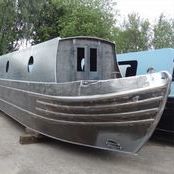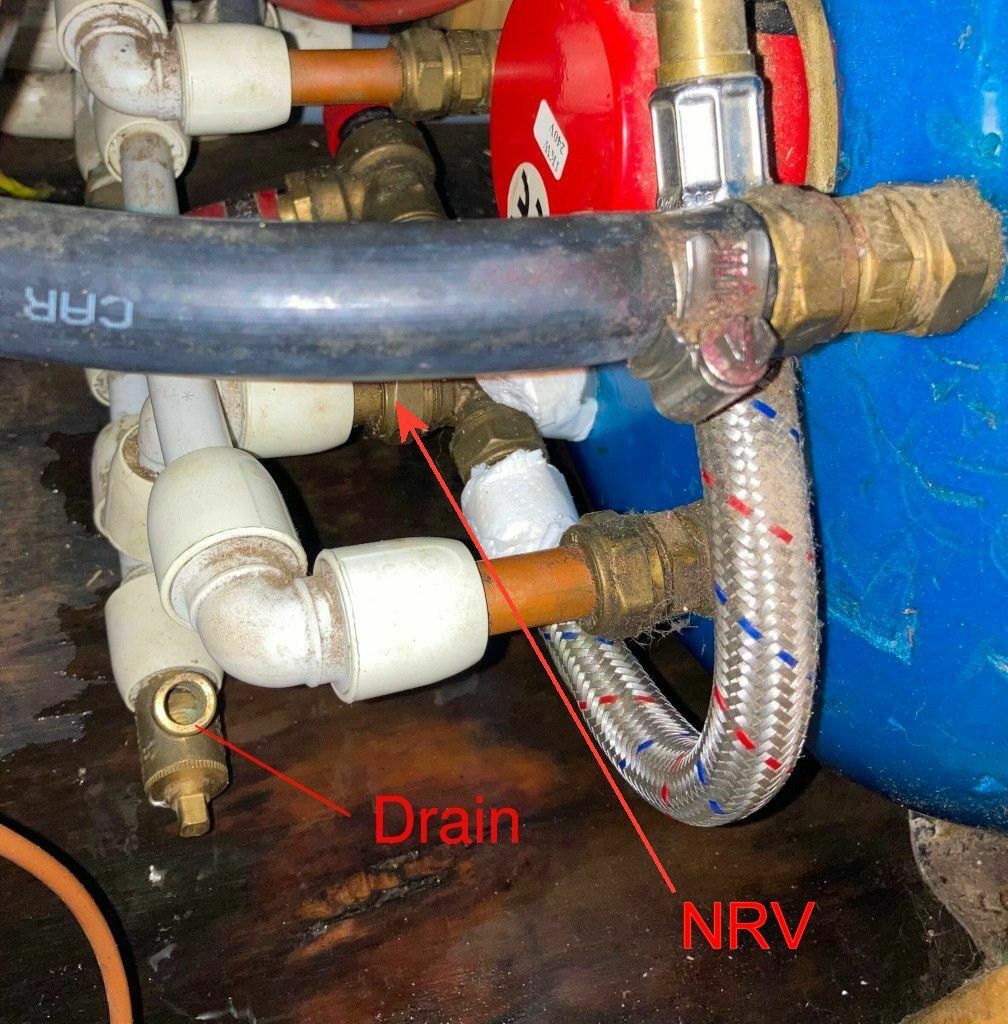-
Posts
974 -
Joined
-
Last visited
Content Type
Profiles
Forums
Events
Gallery
Blogs
Store
Everything posted by PeterF
-

Over voltage on Shires twin alternator engine.
PeterF replied to Tracy D'arth's topic in Boat Equipment
It was on the engine, here is an image from my old boats manual, ignore the pencil mark ups because I swapped the alternator, the link is shown as the dashed line between the terminal posts with explanation box. -

Over voltage on Shires twin alternator engine.
PeterF replied to Tracy D'arth's topic in Boat Equipment
On my old boat noted above, the domestic alternator had a feed from the panel, I can not recall the purpose of it, but the feed from the panel went to a relay and the relay then connected the domestic 12V positive to the domestic alternator, may be an excitation feed. This kept the two systems separate, if someone replaced the relay with a direct connection that could give a way for voltage parity, but it could involve a lot of current to flow through thin wires. -

Over voltage on Shires twin alternator engine.
PeterF replied to Tracy D'arth's topic in Boat Equipment
Previous boat had a Barrus Shire engine, based on Yanmar, 2002 build, 80A and 40A alternators on single belt, gobbled belts like no tomorrow. Some Victron inverters have a trickle charge for the engine battery, which is basically a take off from the inverters 12V feed with a low voltage drop diode. My current boat has this and the starter battery pretty much follows the domestic battery albeit a bit lower. If thd domestic alternator over voltages then so does the starter battery. The same is true if the solar also over voltages. -
PRO Cast Notts do a range of wood effect fibre glass porthole and window liners. They also do standard brass and chrome porthole liners. https://www.procastnotts.com/index.php/liners-fibreglass_liners/?k=48618:38:::
-
Went down to the boat today, lifted the knobs up 5mm and all 3 rings lit straight away. Common mode failure on 3 independent burners - cleaning the hob. Thanks for the advice on this, which was well received before I started trying to do anything else to fix it.
-
Thanks for this update, i plan on visiting my boat in a few days so I will be sure to take some kitchen foil with me.
-
The hob in question does not have a lid, the only commonality on the 3 burners / thermocouples / valve assemblies / knobs is the gas supply which makes it weird to work out the issue. The thermocouples do not have a common power supply, the voltage generated by the thermocouples is used directly in the valves.
-
This has happened to mine, boat is not used over winter, it first happened in early December when I went to winterise the boat and then again when I visited to check in January. I need to sort it before spring. The first thought I have is damp if it got into the connectors as we got a fair bit of condensation on the winterising visit. The second thought is lower than normal temperature on the boat when last visited which would have needed the knobs holding down for longer. My plan on the next visit is to hold the knobs in longer and if still no joy then check the connectors. Both of these thoughts would affect all 3 burners. The only other thing is checking the knobs as mentioned above because I recall that my wife removed them to clean the hob after out last trip. The thermocouples produce a very small voltage and anything impeding this could easily cause trouble. I found the following link with some info. https://www.caravantalk.co.uk/community/topic/143848-thetford-spinflo-enigma-hob-flame-will-not-stay-alight/
-
Cheers, confirms my thoughts were right, just worried I was missing something.
-
My boat has a beta 43 and I was pondering the 2 negative wires, one ostensibly for engine battery and the other for domestic according to the manual, but as both alternators are negative return via the bodies and the negatives are bolted to the engine rails, then the negative cables appear to be parallel return paths rather than dedicated return paths. Have i got this right, your post suggests I have because I have been thinking about adding a shunt.
-
Email Balmar, say you have on old unit with your firmware revision number and can not find the manual and ask if the have a copy of the manual that matches this version. You may come up lucky.
-
As said above, the pump is starved. Most pumps will pump air, so 1. Turn the pump off. 2. Turn off the water feed from the holding tank at the stop cock. 3. Open all the taps, hot and cold. 4. Undo the pipe somewhere between the stop cock and the pump. Have a rag ready as a little water will leak. 5. Turn the pump on, it should now suck in air and blow this through the pipes. The problem can be emptying the calorifier as the hot water outlet is at the top. On my horizontal one, when the pump is running on air as per step 5, 6. Close all the taps and the calorifier pressures up. 7. Release the pressure relief valve (PRV) by turning the red knob, the air pressure in the top of the calorifier will blow the water out of the bottom. 8. Close the PRV and repeat step 7 until air blows out. 9. Turn off the pump, reconnect the water feed pipe and open the taps. 10. Disconnect the heating water coils and 230V immersion cable as required.
-
This looks like a Surecal calorifier, just be aware that the often have a built in non return valve (NRV) in the brass manifold fitting as shown below which stops them draining out, although the who installed yours may have removed it given a drain has been added. I added a drain like that on my previous boat and had to remove the NRV, adding an in line one in the cold supply pipe the other side of the drain.
-

How much is too much Solar Power and how much is just enough?
PeterF replied to Porcupine's topic in New to Boating?
The Mastervolt Alpha Pro regulator has two positive supplies like a lot of these regulators, one is the main power supply for the field coil and the other is intended to be switched to turn the regulator on and off and only has a small current demand. The control wire is, normally switched from the ignition via a relay for a standard install with lead acid, but for lithium you could wire this through the BMS "allow to charge" connection/ relay if it has enough current capacity or via another relay. The Balmar and Wakespeed units are the same. -

Finding mystery leak in central heating system.
PeterF replied to frlrubett's topic in Boat Building & Maintenance
Building on Tony's and Nick's replies, if there is air in the radiators, then when things heat up the expansion will be more than with water, so the chances of overflowing are increased. Viscous circle, air in system causes more expansion and overflow, when it cools down, more air is sucked in, next heating cycle causes even more expansion, overflowing even more. Each cycle things get worse. -
I know I am a bit late on this one. I studied at Loughborough University and at one point presented at a conference in the US. I got introduced as .... gained his Masters degree from Lowbrow University in England .... and stood there in front of 400+ people trying not to crack up. Next time I presented I spelled it phonetically for the session chairman.
-
There was no technical reason given, there was no untoward metal loss, it was just stated as best practice for future protection as Ex Brummie said. Which is why I told the buyer I would not reduce the price.
-
As that looks like a Surecal calorifier, the non return valve is integral in the manifold arrangement so Surecal recommend putting the expansion vessel on the warm outlet pipe. This prevents the dripping of the PRV but is not the ideal location.
-
Regarding your question about grit blasting and 2 pack epoxy on the hull, this seems to be a recent thing that surveyors are recommending. We sold an 18 year old boat last year, started with a 12mm base plate, never been on shore power in a marina and baseplate readings were above 11mm, but the surveyor stated it should be blasted and 2 packed so the buyer was asking £5,000 of the price. I said no.
-
This is not the case. This clause was in the proposed T&C that were published during the consultation process but this clause was removed from the T&C when they were published after the consultation. The current T&C (Link to current T&C) does not contain this clause. The closest I can find in the current T&C is 4.3.3. the Boat’s livery does not display an association with any company engaged in a boat share business. which is to distinguish between private boat share schemes and commercial boat chare schemes. Half the thread is a moot discussion.
-
An inverter charger is either charging or inverting, it can not do both at the same time, so when it detects mains supply from shore power or the travel power it stops inverting and goes to charger and passes the mains through the unit. You do not need to turn it to charger only, so when the travel power stops, the inverter picks back up automatically.
-
Andy, The fabrication quality of the boat looked good, it was the design /aesthetics that I meant as being clunky, the wrapped stern looks like an afterthought and the way the taff rail is attached is not brilliant and the very pinched in cratch window and small bow locker also look a bit odd. My guess is that the owners, who had it built wanted it like this. There is also the leaning chimney, why not fit an angled through roof fitting like most boat builders so the chimney is vertical.
-
We moored next to a Pintail Boats / Forton fit out for a few years that is now for sale, https://www.aqueductmarina.co.uk/second-hand-boats/the-owl-the-pussycat/. The design of the shell was a little clunky especially around the stern and bow but that may have been owners spec, otherwise it was OK. We never went inside so no clue to the fit out competency.
-
Aqua Narrowboats, they often use Colecraft shells and have fitted out some boats for taller people. Not cheap and into 2023 for the next build slot.
-

Breaker or fuse between solar panel and controller?
PeterF replied to MichaelG's topic in Boat Equipment
When you have one of the Epever Tracer controllers having a switch between the panels and controller can get used more as these controllers can get stuck at a low output if there is intermittent sun and shade. Stopping the current flow from the panels caused the controller to do a new maximum power sweep and get back to full output. Gone Victron now and no more switching the panels on and of a couple of times a week.







